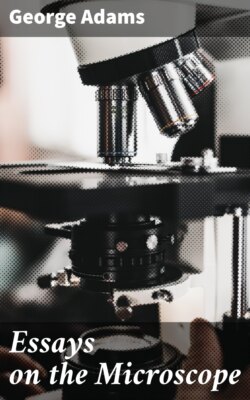Читать книгу Essays on the Microscope - George Comp Adams - Страница 13
На сайте Литреса книга снята с продажи.
OF THE DOUBLE OR COMPOUND MICROSCOPE.
ОглавлениеTable of Contents
In the compound microscope, the image is viewed instead of the object, which image is magnified by a single lens, as the object is in a single microscope. It consists of an object lens N L, Fig. 5. Plate I. and an eye glass F G. The object B O is placed a little further from the lens than its principal focal distance, so that the pencils of rays proceeding from the different points of the object through the lens, may converge to their respective foci, and form an inverted image of the object at Q P; which image is viewed by the eye through the eye glass F G, which is so placed, that the image may be in its focus on one side, and the eye at the same distance on the other. The rays of each pencil will be parallel, after passing out of the glass, till they reach the eye at E, where they will begin to converge by the refractive powers of the humours; and after having crossed each other in the pupil, and passed through the crystalline and vitreous humours, they will be collected in points on the retina, and form a large inverted image thereon.
It will be easy, from what has been already explained, to understand the reason of the magnifying power of a compound microscope. The object is magnified upon two accounts; first, because if we viewed the image with the naked eye, it would appear as much larger than the object, as the image is really larger than it, or as the distance f R is greater than the distance f b; and secondly, because this picture is again magnified by the eye glass, upon the principle explained in the foregoing article on vision, by single microscopes.
But it is to be noted, that the image formed in the focus of a lens, as is the case in the compound microscope, differs from the real object in a very essential particular; that is to say, the light being emitted from the object in every direction, renders it visible to an eye placed in any position; but the points of the image formed by a lens, emitting no more than a small conical body of rays, which arrives from the glass, can be visible only when the eye is situate within its confine. Thus, the pencil, which emanates from o in the object, and is converged by the lens to D, proceeds afterwards diverging towards H, and, therefore, never arrives at the lens F G, nor enters the eye at E. But the pencils which proceed from the points o and b, will be received on the lens F G, and by it carried parallel to the eye; consequently, the correspondent points of the image Q P will be visible; and those which are situate farther out towards H and I, will not be seen. This quantity of the image Q P, or visible area, is called the field of view.
Hence it appears, that if the image be large, a very small part of it will be visible; because the pencils of rays will for the most part fall without the eye glass F G. And it is likewise plain, that a remedy which would cause the pencils, which proceed from the extremes B and O of the object, to arrive at the eye, will render a greater part of it visible: or, in other words, enlarge the field of view. This is effected by the interposition of a broad lens D E, Fig. 5, of a proper curvature, at a small distance from the focal image. For, by those means, the pencil D N, which would otherwise have proceeded towards H, is refracted to the eye, as delineated in the figure, and the mind conceives from thence the existence of a radiant point at Q, from which the rays last proceeded. In like manner, and by a parity of reason, the other extreme of the image is seen at P, and the intermediate points are also rendered visible. On these considerations it is, that compound microscopes are usually made to consist of an object lens N L, by which the image is formed, enlarged, and inverted; an amplifying lens D E, by which the field of view is enlarged, and an eye glass or lens, by which the eye is allowed to approach very near, and consequently to view the image under a very great angle of apparent magnitude. It is now customary to combine two or more lenses together at the eye glass, in the manner of Eustachio Divinis and M. Joblot; by which means the aberration of light from the figure is in some measure corrected, and the apparent field increased.
